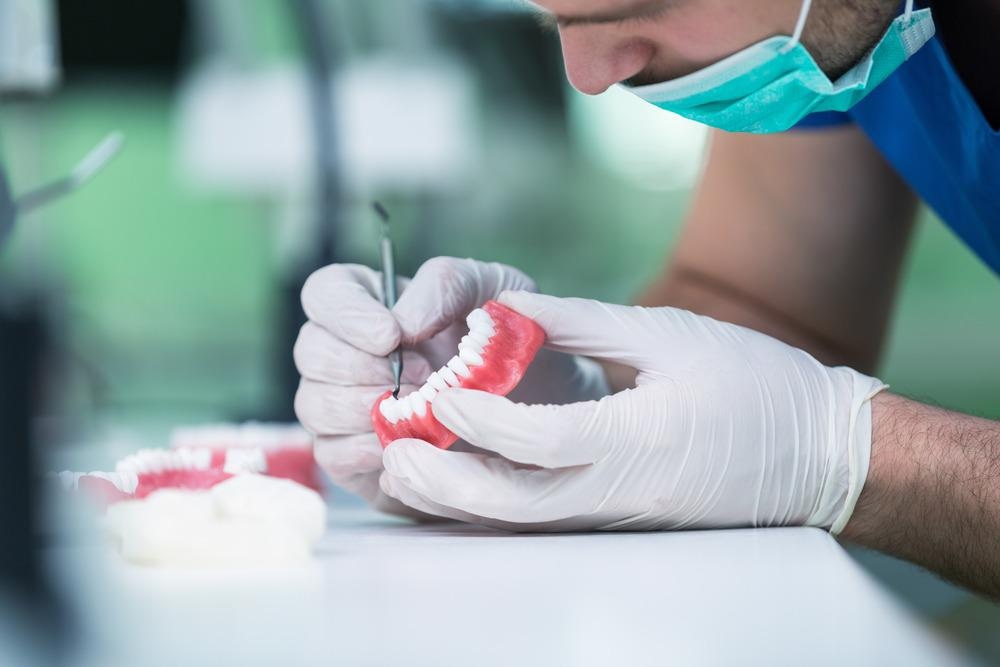Bacterial plaque is an ever-present issue for dental hygiene. It grows and proliferates on the surface of teeth and on dental implants. To inform the development of improved dental prostheses, a study published in The Journal of Prosthetic Dentistry has compared plaque accumulation on titanium and zirconia-based fixed dental prostheses.

Study: Titanium versus zirconia complete-arch implant-supported fixed prostheses: A comparison of plaque accumulation. Image Credit: FS Stock/Shutterstock.com
Bacterial Plaque
Bacteria are an ever-present part of the mouth’s environment. They feed on sugars and other molecules present in food and drink and are difficult to remove without regular brushing. Bacterial plaque is comprised of extracellular bacterial products and salivary glycoproteins. It tenaciously adheres to the surface of teeth, implants, and dental prostheses. An organic matrix, the dental plaque has a highly organized predominantly filamentous structure.
Surface roughness is the primary factor that dictates plaque adhesion. The number of deposits on different substrates is related to the surface roughness of the substrate. Studies have reported that a surface roughness over a threshold of 2μm significantly increases bacterial colonization.
High-energy surfaces collect more plaque, increase bacterial bond strength, and have an affinity for specific bacterial strains. Whilst both variables interact with each other, surface roughness is the predominant factor for inducing bacterial plaque growth.
Plaque Growth on Implants and Prostheses
Dental implants and prostheses are commonly employed to replace the teeth lost in edentulous patients. Similar methods of subgingival plaque formation have been reported in patients with these dental implants. It has been reported that bacterial morphotypes are similarly distributed in both implants and natural teeth. Bacterial strains have been observed to be the same in patients with both healthy implants and those with healthy natural teeth.
Studies have also reported that the composition of plaque is different in completely edentulous patients that have implants that replace their missing teeth to those who are only partially edentulous. Other studies have reported that the bacterial strains observed in peri-implant mucositis are like strains that occur in gingivitis. Furthermore, in infection sites that occur in pert-implants, bacterial strains are nearly identical to those that proliferate in periodontitis sites.
The bacterial microflora around infected peri-implantitis sites is mostly composed of gram-negative bacteria, but Staphylococci and Peptostrepoccoci strains have been found in some patients. Chemical and mechanical interventions that disrupt the bacterial biofilm on implants lead to positive health outcomes for patients.
Titanium and Zirconia Implants and Dental Hygiene
Titanium and zirconia are two commonly used materials for dental implants and prostheses in edentulous patients. Kanao et al. investigated and compared plaque accumulation and blood flow in patients who had complete-arch implant-supported prostheses that were built from titanium, acrylic resin, or composite resin.
These implants are designed to be in contact with soft tissue. The results of their research demonstrated that titanium implants improved dental hygiene, reduced plaque adhesion, and caused less inflammation than resin alternatives.
Further Reading: The Use of Graphene in Dentistry
In another study, disks composed of different materials were fixed to the mouths of volunteers for 24 hours. After removal, it was observed that there was significantly less bacterial adhesion on the zirconia disks compared to the titanium disks. Van Brakel et al. reported that around zirconia abutments, peri-implant soft tissue displayed shallower bacterial probing depth, compared to titanium abutments. Additionally, there was no difference in other clinical parameters and bacterial colonization composition.
Bremer et al. have observed less relative adhesion by bacterial species in zirconia compared to 4 other tested ceramics for implant design. The results observed for zirconia implants in studies has facilitated the further investigation of these materials for future dental implant development in a clinical setting.
Titanium vs. Zirconia Dental Prostheses: A Comparative Study
The authors of the research published in The Journal of Prosthetic Dentistry have presented a longitudinal descriptive clinical study to compare titanium and zirconia dental prostheses. In the study, the plaque accumulation and inflammation of soft tissue around implants were compared and studied.
The team proposed a null hypothesis that plaque accumulation on the intaglio surface of the prostheses would be similar. However, when this hypothesis was tested, it was rejected as plaque accumulation on the intaglio surface of titanium prostheses was significantly higher than zirconia implants at all time points. Additionally, plaque accumulation in the titanium prostheses did not respond to oral hygiene and maintenance procedures.
Based on the clinical study’s findings, the team concluded that zirconia was the superior material option for dental prostheses. It displayed less plaque accumulation than titanium after periodic maintenance and good oral hygiene procedures. Titanium performed poorly, responding insufficiently to maintenance and oral hygiene, with plaque accumulation at all time points, facilitating the need for custom maintenance protocols for patients.
Soft tissue reddening and inflammation were related to areas of plaque accumulation, which could facilitate the implementation of implant removal and cleaning during maintenance procedures. Based on the observations of both materials, the authors concluded that zirconia responds better than titanium to plaque control measures.
Further Reading
Curiel-Aguilera, F.P. et al. (2021) Titanium versus zirconia complete-arch implant-supported fixed prostheses: A comparison of plaque accumulation [online] The Journal of Prosthetic Dentistry | sciencedirect.com. Available at: https://www.sciencedirect.com/science/article/abs/pii/S0022391321005850
Disclaimer: The views expressed here are those of the author expressed in their private capacity and do not necessarily represent the views of AZoM.com Limited T/A AZoNetwork the owner and operator of this website. This disclaimer forms part of the Terms and conditions of use of this website.